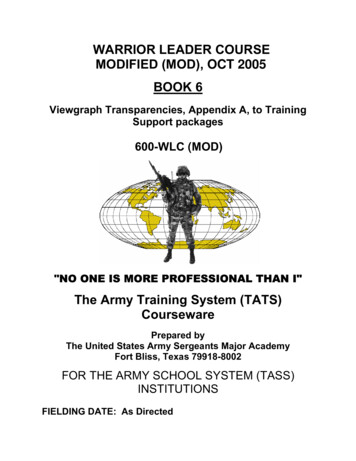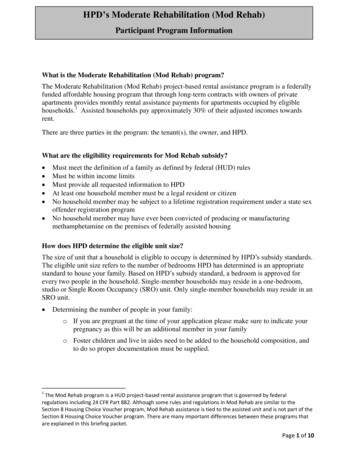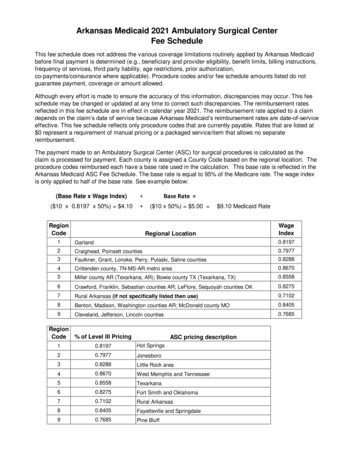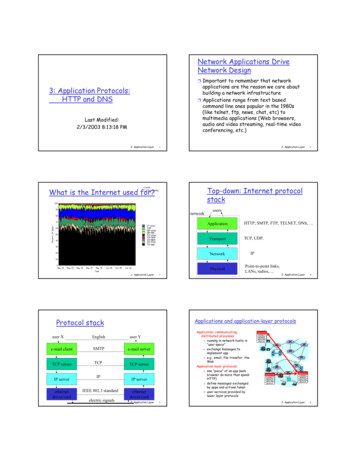
Transcription
WARRIOR LEADER COURSEMODIFIED (MOD), OCT 2005BOOK 6Viewgraph Transparencies, Appendix A, to TrainingSupport packages600-WLC (MOD)"NO ONE IS MORE PROFESSIONAL THAN I"The Army Training System (TATS)CoursewarePrepared byThe United States Army Sergeants Major AcademyFort Bliss, Texas 79918-8002FOR THE ARMY SCHOOL SYSTEM (TASS)INSTITUTIONSFIELDING DATE: As Directed
This page intentionally left blank
INTRUCTOR / STUDENTRECOVERABLE MATERIALThis instruction material is ACCOUNTABLE/RECOVERABLE. Instructorsand students MUST TURN IN this material upon course completion or uponreassignment to other duties.The Army School System (TASS) Institutions are responsible for the issueand control of this material.To receive additional or replacement material requires that a WRITTENJUSTIFICATION be forwarded to ATSC through Command Channels.This book contains the viewgraph transparencies to the following TrainingSupport Packages: (NOTE) The order given below is in the same order asthe recommended sequence found in the Course Map in the CourseManagement Plan.For NCOAs that show the VGTs digitally, they may download them fromthe USASMA 25L226L227T229TitleIntroduction to PLDCSuicide PreventionPhysical FitnessRisk ManagementConduct an After Action ReviewIntroduction to Army LeadershipWhat a Soldier Must Be, Know, DoThe Human Dimension Role in LeadershipDevelopmentThe Four Direct Leadership SkillsThe Three Direct Leadership ActionsMaintain DisciplineEnforce the Equal Opportunity ProgramWear and Appearance of the Uniform
26L233TitleConduct Developmental CounselingSexual AssaultFinancial ManagementSupply ProceduresSupervise Preventative Maintenance Checks andServicesTraining the ForceMap ReadingCombat OrdersConduct MovementOccupy an Assembly AreaCombat OperationsLand NavigationHistory of the NCOPrinted and distributed by: U.S. Army Training Support Center, TrainingMedia Support Directorate, Training Medial Management Team, FortEustis, VA 23604-5168
Appendix A, Viewgraph TransparenciesTSP: L232TITLE: Introduction to PLDC
This page intentionally left blank
PLDC OBJECTIVE:To set the standards expected of allprospective and newly appointedsergeants.L232/MAR 05/VGT-1
MAJOR AREAS OFINSTRUCTION Leadership Training WarfightingL232/MAR 05/VGT-2
COMMON TASKSTECHNICAL TASKS—SKILL LEVELS 1- 4COMMON TASKS—SKILL LEVELS LLSBASICWARFIGHTINGSKILLSL232/MAR 05/VGT-3
PLDC TOPICS1. Leadership in a garrisonenvironment.2. Training in a garrisonenvironment.3. Leadership in a field environment.4. Training in a field environment.5. NCO responsibilities.L232/MAR 05/VGT-4
LEADERSHIP BLOCK1. Introduction to Army Leadership2. What a Leader must BE, KNOW, DO3. The Human Dimension Role inLeadership Development4. The Four Direct Leadership Skills5. The Three Direct Leadership Actions6. Maintain Discipline7. Enforce the Equal OpportunityProgram8. Conduct Developmental CounselingL232/MAR 05/VGT-5
LEADERSHIP BLOCK(cont)9.10.11.12.13.L232/MAR 05/VGT-6Financial ManagementSexual AssaultCommandant’s OrientationIntroduction to PLDCIdentify the Historical Progression ofthe NCO Corps
TRAINING BLOCK1. Risk Management2. Conduct an AAR3. Training the Force4. Supervise Physical FitnessTrainingL232/MAR 05/VGT-7
TRAINING BLOCK (cont)5. Conduct Drill and Ceremonies6. Wear and Appearance of the Uniform7. Supervise PMCS8. Supply Procedures9. Suicide PreventionL232/MAR 05/VGT-8
WARFIGHTING BLOCK Combat Orders Move Tactically Occupy an Assembly Area Combat Operations Map Reading Land Navigation STXL232/MAR 05/VGT-9
SITUATIONAL TRAINING EXERCISE(STX) BLOCK24 HoursLeadership evaluationSquad tacticsL232/MAR 05/VGT-10
INTRODUCTIONS Your name.Place of birth (hometown)Point of entry into the Army.Date of entry into the Army.Location of basic combat training.Location of advanced individualtraining. Current unit of assignment. MOS and duty position.L232/MAR 05/VGT-11
This page intentionally left blank
Appendix A, Viewgraph TransparenciesTSP: T240TITLE: Suicide Prevention
This page intentionally left blank
Suicide PreventionIn The Army’s SuicidePrevention ProgramEveryone Matters!T240/OCT03/VGT-1Primary Leadership Development Course
Goal of the Army SuicidePrevention ProgramTO MINIMIZE SUICIDAL BEHAVIORAMONG OUR SOLDIERS, RETIREES,CIVILIANS AND FAMILY MEMBERS.T240/OCT03/VGT-2Primary Leadership Development Course
Chief of Staff of the ArmyStatementThe CSA stated that suicide is a “seriousproblem” and directed a complete review ofthe ASPP. He called for a campaign thatwould refine the ASPP by making use of thebest-known available science, and wouldalso invigorate suicide prevention awarenessand vigilance.T240/OCT03/VGT-3Primary Leadership Development Course
Chief of Staff of the ArmyStatement (cont)The CSA further stated that for the programto be effective, the frame work must: involve all commanders be proactive intensify preventive efforts against suicidalbehavior invest in our junior leaders improve current training and educationT240/OCT03/VGT-4Primary Leadership Development Course
Possible Mental Disorders Impulsive or aggressive-violent traits Previous other self-injurious acts Excessive anger, agitation, or constrictedpreoccupations Excessive alcohol use Heavy smoking Evidence of any sleep or eating disorderT240/OCT03/VGT-5Primary Leadership Development Course
Suicide Potential “Triggers” Loss of a loved one to illness or deathLoss of a significant, intimate relationLoss of a child custodyLoss of friendship or social statusLoss of job or rankT240/OCT03/VGT-6Primary Leadership Development Course
Suicide Potential “Triggers” (cont) Loss of freedomLoss of financial securityLoss of self esteemLoss of hope or feeling helplessLoss or change in lifestyleT240/OCT03/VGT-7Primary Leadership Development Course
Suicide Immediate Danger Signs Talking or hinting about suicide Formulating a plan to include a meansto kill oneself Having a desire to die Obsession with death includinglistening to sad music or poetry orartwork Finalizing personal affairs Giving away personal possessionsT240/OCT03/VGT-8Primary Leadership Development Course
Suicide Warning Signs Obvious drop in duty performanceUnkempt personal appearanceFeeling of hopelessness or helplessnessFamily history of suicidePrevious suicide attemptsDrug or alcohol abuseSocial withdrawalLoss of interest in sexual activityReckless behavior, self-mutilationPhysical heath complaints, changes/loss ofappetite Complaints of significant sleep difficultiesT240/OCT03/VGT-9Primary Leadership Development Course
The Army Suicide PreventionModelAwarenessPreventionFirst line supervisoraware of soldiers facinglife stressor'sFirst line supervisorensures individual receivesrequired assistanceIs soldier suspectedto be at risk forsuicidal?NoYesInterventionVigilanceCommand or supervisorensure complete -10Is soldier atrisk forsuicidal?NoYesCommand or supervisorensures that individualis seen by ASISTqualified vioral healthassessmentSoldier is referred tobehavioral healthPrimary Leadership Development Course
Prevention BarrierPREVENTIONThe “main effort” is to minimize suicide behavior.T240/OCT03/VGT-11Primary Leadership Development Course
Intervention BarrierInterveneThe Intervention barrier prevents any life crisis ormental disorder to lead to thoughts of suicide.T240/OCT03/VGT-12Primary Leadership Development Course
Secure BarrierSecureThe last possible opportunity to preventan act of suicide.T240/OCT03/VGT-13Primary Leadership Development Course
Continuity of CareContinuity of Care is the safety net underneaththe suicide model that represent what the Armyis required and obligated to provide thoseindividuals at risk for suicide.T240/OCT03/VGT-14Primary Leadership Development Course
Installation GatekeepersPrimary Gatekeepers Chaplains & chaplin assistants ADAPCP counselors Family Advocacy Programworkers AER counselors Emergency room medicaltechnicians Medical health professionalsT240/OCT03/VGT-15Secondary Gatekeepers Military policeTrial defense lawyersYouth servicesInspector general officeDOD school counselorsMWR workersRed Cross workersPrimary Leadership Development Course
All Soldiers Checklists Know suicidal danger & warning signs andthe leading causes for suicide. Take immediate action when suspectingsomeone is suicidal or if someone admitsthat they are contemplating suicide. Become aware of local services an protocolsfor use.T240/OCT03/VGT-16Primary Leadership Development Course
First Line Supervisors/LeadersChecklists Get to know your soldiers so that you can recognizeand even anticipate possible dysfunctional behavior. Assess each of your soldier’s life-coping skills. Seekopportunities to positively influence your soldier’sbehavior. Ensure proper training of all your soldiers in suicideprevention/awareness. Create an atmosphere of inclusion for all. Neverostracize any of your soldiers, regardless of theiractions.T240/OCT03/VGT-17Primary Leadership Development Course
First Line Supervisors/LeadersChecklists (cont) Know potential warning signs for mental illness. Know potential triggers for suicide. Set the example, take advantage of availablehelping services. Reduce the perceived stigma regarding mentalhealth. Remember that most mental illnesses aretreatable and are a result of a sickness, notweakness.T240/OCT03/VGT-18Primary Leadership Development Course
SummarySuicide Prevention is Everybody's Businessand in the ArmyEVERYONE MATTERS!T240/OCT03/VGT-19Primary Leadership Development Course
This page intentionally left blank
Appendix A, Viewgraph TransparenciesTSP: T224TITLE: Physical Fitness
This page intentionally left blank
PHYSICALFITNESST224/OCT03/VGT-1Primary Leadership Development Course
PHYSICAL FITNESS TRAININGPROGRAM OBJECTIVETO ENHANCE COMBAT READINESS BY DEVELOPINGAND SUSTAINING A HIGH LEVEL OF PHYSICAL FITNESSIN SOLDIERS AS MEASURED BY:CARDIORESPIRATORY ENDURANCEMUSCULAR STRENGTH AND ENDURANCEFLEXIBILITYBODY COMPOSITION STANDARDS AS PRESCRIBEDBY AR 600-9¾ MOTOR EFFICIENCY (COORDINATION, AGILITY,BALANCE, POSTURE, SPEED, POWER, ANDKINESTHETIC AWARENESS).¾¾¾¾T224/OCT03/VGT-2Primary Leadership Development Course
PHYSICAL FITNESS TRAININGPROGRAM OBJECTIVE (cont)¾ ANAEROBIC CONDITIONING¾ COMPETITIVE SPIRIT, THE WILL TO WIN,AND UNIT COHESION¾ SELF-DISCIPLINE¾ A HEALTHY LIFESTYLE THAT INCLUDESGOOD NUTRITION, EXCLUDES SMOKING,AND AVOIDS MISUSE OF ALCOHOL ANDDRUGS¾ ABILITY TO COPE WITH ALL TYPES OFSTRESST224/OCT03/VGT-3Primary Leadership Development Course
COMPONENTS OF FITNESS CARDIORESPIRATORY ENDURANCEMUSCULAR STRENGTHMUSCULAR ENDURANCEFLEXIBILITYBODY COMPOSITIONT224/OCT03/VGT-4Primary Leadership Development Course
PRINCIPLES OF CITYRECOVERYOVERLOADT224/OCT03/VGT-5Primary Leadership Development Course
FLEXIBILITYFLEXIBILITY IS THE ABILITY TO MOVE THEJOINTS OR ANY GROUP OF JOINTS THROUGHAN ENTIRE, NORMAL RANGE OF MOTION.T224/OCT03/VGT-6Primary Leadership Development Course
STRETCHING TECHNIQUES STATIC PASSIVE PROPRIOCEPTIVENEUROMUSCULARFACILITATION (PNF) BALLISTICT224/OCT03/VGT-7Primary Leadership Development Course
FACTORS FOR A SUCCESSFULTRAINING imary Leadership Development Course
TRAINING HEART RATE220 - AGEMAX HR- MAX HRRHRHRR( % x ) HRRRHRTHRT224/OCT03/VGT-9Primary Leadership Development Course
CRITERIA FOR AN AEROBICACTIVITY USES THE LARGE MUSCLES OF THE BODY CONTINUOUS, RYTHMICAL, AND REPETITIVE VIGOROUS ENOUGH TO RAISE AND SUSTAINTHE HEART RATE AT A TRAINING LEVEL FOR AMINIMUM OF 20 MINUTEST224/OCT03/VGT-10Primary Leadership Development Course
EXAMPLES OF NGCYCLINGEXERCISING TO TBALLRACQUETBALLPrimary Leadership Development Course
PHASES OF CONDITIONING PREPARATORY CONDITIONING MAINTENANCET224/OCT03/VGT-12Primary Leadership Development Course
Appendix A, Viewgraph TransparenciesTSP: T221TITLE: Risk ManagementC1
This page intentionally left blank
BASIC PRINCIPLESFramework for ImplementingIntegrate RiskManagement intoMission, Planning,Preparation andExecutionT221/OCT 03/ VGT-1Making RiskDecisions at theAppropriateLevel in theChain ofCommandAccepting NoUnnecessaryRisk
RISK MANAGEMENT ASSISTS THE COMMANDEROR LEADER IN - CONSERVING LIVES AND RESOURCES ANDAVOIDING UNNECESSARY RISK. MAKING AN INFORMED DECISION TOIMPLEMENT A COA. IDENTIFYING FEASIBLE AND EFFECTIVECONTROL MEASURES WHERE SPECIFICSTANDARDS DO NOT EXIST. PROVIDING REASONABLE ALTERNATIVES FORMISSION ACCOMPLISHMENT.T221/OCT 03/ VGT-2
RISK MANAGEMENT DOES N0T- INHIBIT THE COMMANDER’S AND LEADER’SFLEXIBILITY AND INITIATIVE. REMOVE RISK ALTOGETHER, OR SUPPORT AZERO DEFECTS MINDSET. REQUIRE A GO/NO –GO DECISION. SANCTION OR JUSTIFY VIOLATING THE LAW. REMOVE THE NECESSITY FOR STANDARDDRILLS, TACTICS, TECHINQUES, ANDPROCEDURES.T221/OCT 03/ VGT-3
THE FIVE STEPS STEP 1. IDENTIFY HAZARDS. STEP 2. ASSESS HAZARDS TODETERMINE RISKS. STEP 3. DEVELOP CONTROLS ANDMAKE RISK DECISIONS. STEP 4. IMPLEMENT CONTROLS. STEP 5. SUPERVISE AND EVALUATE.T221/OCT 03/ VGT-4
TWO TYPES OF RISKS TACTICAL RISKS – RISK CONCERNED WITHHAZARDS THAT EXIST BECAUSE OF THE PRESENCEOF EITHER THE ENEMY OR AN ADVERSARY. ITAPPLIES TO ALL LEVELS OF WAR AND ACROSS THESPECTRUM OF OPERATIONS. ACCIDENT RISK – INCLUDES ALL OPERATIONALRISK CONSIDERATIONS OTHER THAN TACTICALRISK. IT INCLUDES RISKS TO THE FRIENDLYFORCE. IT ALSO INCLUDES RISKS POSED TOCIVILIANS BY AN OPERATION, AS WELL AS ANOPERATIONS IMPACT ON THE ENVIRONMENT.T221/OCT 03/ VGT-5
RISK MANAGEMENT PROCESSStep OneIdentify HazardsMissionT221/OCT 03/ VGT-6EnemyWeather/TerrainTimeTroops
RISK MANAGEMENT PROCESSStep TwoAssess Hazards to Determine RisksSub-Step A: Assess ThreatProbabilitySub-Step B: Assess ThreatSeveritySub-Step C: Estimate Risk LevelsT221/OCT 03/ VGT-7
RISK MANAGEMENT PROCESSStep ThreeDevelop Controls and Make RiskDecisionsDevelop ControlsMake Risk DecisionsT221/OCT 03/ VGT-8
RISK MANAGEMENT PROCESSStep FourImplement ControlsMakeImplementationClearT221/OCT 03/ VGT-9Coordinate &CommunicateProvideSupport
RISK MANAGEMENT PROCESSStep FiveSupervise and EvaluateSUPERV ISET221/OCT 03/ VGT-10EVALUATE
FRATRICIDE DEFINED“The employment of friendlyweapons that results in the unforeseen andunintentional death or injury of friendlypersonnel or damage to friendlyequipment.”(FM 17-98)T221/OCT 03/ VGT-11
EFFECTS OF FRATRICIDELoss of confidence in unit’s leadership.Increasing self-doubt among leaders.Hesitancy in the employment of supporting combat systems.Over supervision of units.Hesitancy in the conduct of night operations.T221/OCT 03/ VGT-12
EFFECTS OF FRATRICIDE,(Cont)Loss of aggressiveness in maneuver (fire and movement).Loss of initiative.Disrupted operations.General degradation of unit cohesiveness, morale, and combatpower.T221/OCT 03/ VGT-13
CAUSESOFFRATRICIDEYep,AircraftFailures in the direct fire control plan.Land and navigation failures.Failures in combat identification.Inadequate control measures.T221/OCT 03/ VGT-14
CAUSESOFFRATRICIDE,(Cont)Failures in reporting and communications.Weapons errors.Battlefield hazards.T221/OCT 03/ VGT-15
This page intentionally left blank
Appendix A, Viewgraph TransparenciesTSP: T222TITLE: Conduct an After Action Review
This page intentionally left blank
PLANNING Who will observe the training and who willconduct the AAR. Reviewing the training and evaluation plan. Schedule stopping points. What trainers should evaluate. Who attends. When and where the AAR will occur. What training aids will be used.T222/ OCT 03 / VGT-1
PREPARING Review training objectives, orders and doctrine. Identify key points. Observe the training and take notes. Select the AAR site. Collect observations from other observers andcontrollers. Organize. Rehearse.T222/ OCT 03/ VGT-2
CONDUCTING Introduction and rules. Generate discussions. Review of objectives and intent. Commander’s mission and intent. OPFOR commander’s missionand intent. Summary of events. Closing comments.T222/ OCT 03 / VGT-3
BENEFITS OF THE AAR Critical Assessment tool. Helps plan soldier training. Helps correct deficiencies.T222/ OCT 03 / VGT-4
Appendix A, Viewgraph TransparenciesTSP: L221TITLE: Introduction to Army Leadership
This page intentionally left blank
TESI BUATTRVALKNOWNSBETIOACUESof Character and Competence ActsLLSSKILeadership FrameworkTHE LEADERDOto Achieve ExcellenceLoyaltyDutyRespectSelfless calTacticalInfluencing Communicating Decision Making MotivatingOperating Plan/Prep Executing AssessingImproving Developing Building Learning
Leadership DefinedLeadership is INFLUENCING people--byproviding purpose, direction, and motivation-while OPERATING to accomplish themission and IMPROVING the organization.L221/OCT03/VGT-2
Three Levels of LeadershipStrategicLeadershipSkills &ActionsOrganizationalLeadershipSkill & ActionsDirect LeadershipSkills & ActionsValues and SocietalPerspectiveOrganizational/Systemsand ProcessesPerspectiveIndividual/SmallGroup Task OrientedPerspective
Squad Leader Situation ExerciseYou are a squad leader. The platoon sergeantmade changes in how the platoon prepares togo to the field. You feel the changes will causeproblems for your squad to prepare properly,and you don’t agree with the changes.What are your responsibilities as a leader?L221/OCT03/VGT-4
Expected Responses toSituation Exercise Ensure PSG’s changes are put into place. Schedule a time to meet with the PSG to explainyour reasons for disagreement. Support the PSG and his decision as though it isyour own, regardless of the outcome of themeeting and the decision made. Show your subordinates that you support thePSG and his changes.L221/OCT03/VGT-5
SQUAD’S REACTIONSSITUATION EXERCISEThe squad leader just returned from his meeting withthe PSG. It is evident the squad leader is mad. Hegathers the squad and tells them sarcastically, “Wellguys, it’s a dumb decision, but we have to do itanyway.”What will be the reactions to the squad leadersbehavior, and what could the consequences be?L221/OCT03/VGT-6
EXPECTED RESPONSES TO SQUAD’SREACTIONSThe squad observes their leader: Undermining the chain of command. Not supporting the platoon sergeant (disloyalty). Supporting decisions he favors and not those he doesn’t. Setting a bad example to the squad.Consequences: Squad starts treating squad leader’s orders in the samemanner. Squad may determine: “If the squad leader is disloyal to thePSG, he is probably disloyal to us too.” (Mistrust).L221/OCT03/VGT-7
This page intentionally left blank
Appendix A, Viewgraph TransparenciesTSP: L222TITLE: What a Leader Must Be, Know, Do
This page intentionally left blank
Primary Leadership Development Course
TESI BUATTRVANSTIOBEACLUESof Character and Competence ActsLLSSKILeadership FrameworkL222/OCT03/VGTL222/OCT03/VGT-2THE LEADERKNOWDOto Achieve ectSelfless ServiceEmotionalHonorIntegrityPersonal CourageInterpersonal CommunicatingConceptualOperating Decision making Motivating Planning/PreparingTechnicalTactical Executing AssessingImproving Developing Building LearningPrimary Leadership Development Course
LOYALTYBear true faith and allegiance to theU.S. Constitution, the Army, yourunit, and other soldiers.If I could tell soldiers one thing, itwould be: have faith. Faith in theArmy, the leadership, and their ownability.Former SMA Robert E. HallL222/OCT03/VGTL222/OCT03/VGT-3Primary Leadership Development Course
DUTYFulfill your obligations.It is difficult to be a goodnoncommissioned officer. If it had beeneasy, they would have given it to theofficer corps.Former SMA William A. ConnellyL222/OCT03/VGTL222/OCT03/VGT-4Primary Leadership Development Course
RESPECTTreat people as they should be treated.Never say "lower enlisted soldiers"- alwayssay "junior enlisted soldiers." Don't use theterm "common soldier"- we are all soldiers ina common cause.Former SMA Gene C. McKinneyL222/OCT03/VGTL222/OCT03/VGT-5Primary Leadership Development Course
SELFLESS SERVICEPut the welfare of the nation,the Army, and yoursubordinates before your own.Are you truly doing what's best for the nation, what'sbest for the Army, what's best for your unit, and what'sbest for your soldiers and their families? Are youtaking all of that into consideration, or are you lookingat what makes you as an individual look the best?Former SMA Richard A. KiddL222/OCT03/VGTL222/OCT03/VGT-6Primary Leadership Development Course
HONORLive up to all the Army values.We build character in order for us to withstand the rigorsof combat and resist the temptations to compromise ourprinciples in peacetime. We must build character inpeacetime because there is no time in war. Character isthe most important quality you can find in any person, butespecially in a soldier. It is the foundation that will getanybody through anything he may encounter. Reputationis what people think you are; character is what you arethat is the staying power.Former SMA Glen E. MorrellL222/OCT03/VGTL222/OCT03/VGT-7Primary Leadership Development Course
INTEGRITYDo what’s right--legally and morally.The core of a soldier is moral discipline. It is intertwinedwith the discipline of physical and mental achievement.It motivates doing on your own what is right withoutprodding. It is an inner critic that refuses to tolerate lessthan your best. Total discipline overcomes adversityand physical stamina draws on an inner strength thatsays "drive on."Former SMA William G. BainbridgeL222/OCT03/VGTL222/OCT03/VGT-8Primary Leadership Development Course
PERSONAL COURAGEFace fear, danger, or adversity(physical or moral).Professional courage is the steel fiber that makes anNCO unafraid and willing to tell it like it is. The conceptof professional courage does not always mean being astough as nails, either. It also suggests a willingness tolisten to the soldiers' problems, to go to bat for them ina tough situation and it means knowing just how farthey can go. It also means being willing to tell the bosswhen he is wrong.Former SMA William A. ConnellyL222/OCT03/VGTL222/OCT03/VGT-9Primary Leadership Development Course
RIBUTESATTESNSTIOVALUACBELLSSKILeadership FrameworkL222/OCT03/VGTL222/OCT03/VGT-10THE LEADERof Character and Competence ActsKNOWDOto Achieve calSelfless ServiceHonorEmotionalIntegrityPersonal CourageInterpersonal CommunicatingConceptualOperating Decision making Motivating Planning/PreparingTechnicalTactical Executing AssessingImproving Developing Building LearningPrimary Leadership Development Course
MENTAL ATTRIBUTES ral AwarenessPrimary Leadership Development Course
STEPS TO TAKE BEFORE DISOBEYINGAN ORDER BELIEVED TO BE ILLEGAL Be sure you understand the details and the originalintent of the order. Seek clarification from the person who gave theorder by asking, for example:* Did you really want me to steal?* You don’t really want me to submit a false report do you?* Do you really want us to shoot the prisoners? Always seek legal advice if the question is complexor time permits.L222/OCT03/VGTL222/OCT03/VGT-12Primary Leadership Development Course
IMMEDIATE DECISION TODISOBEY AN ILLEGAL ORDERMake the best judgment possible based on: Army values Your experiences Your previous study and reflectionL222/OCT03/VGTL222/OCT03/VGT-13Primary Leadership Development Course
UTESATTRIBESNSTIOVALUACLLSBES KILeadership FrameworkL222/OCT03/VGTL222/OCT03/VGT-14THE LEADERof Character and Competence ActsDOKNOWto Achieve calSelfless ServiceHonorEmotionalIntegrityPersonal CourageInterpersonal CommunicatingConceptualOperating Decision making Motivating Planning/PreparingTechnicalTactical Executing AssessingImproving Developing Building LearningPrimary Leadership Development Course
UTESATTRIBVALUBENSTIOACESof Character and Competence ActsLLSSKILeadership FrameworkL222/OCT03/VGTL222/OCT03/VGT-15THE LEADERDOKNOWto Achieve calSelfless ServiceHonorEmotionalIntegrityPersonal CourageInterpersonal CommunicatingConceptualOperating Decision making Motivating Planning/PreparingTechnicalTactical Executing AssessingImproving Developing Building LearningPrimary Leadership Development Course
This page intentionally left blank
Appendix A, Viewgraph TransparenciesTSP: L223TITLE: The Human Dimension Role in Leadership Development
This page intentionally left blank
Three Major ElementsImportant in the makeup and success ofthe Soldier, Team, and Institution Discipline Morale Taking care ofsoldiersL223/ OCT 03/ VGT-1
Three Factors to HighMorale Good leadership Shared hardships Mutual respectL223/ OCT 03/ VGT-2
Taking Care of Soldiers Create a disciplinedenvironment. Set the example. Hold soldiers to highstandards. Demand soldiers do theirduty. Train soldiers to perform inpeace and war. Train soldiers rigorously. Treat soldiers fairly. Give soldiers all resourcesneeded to survive incombat. Share in soldiers’ hardships. Provide family support.L223/ OCT 03/ VGT-3
Leadership Challenges fromTechnology Learning strengths and weaknessesof different technologies. Learning how technologies matchbetween your unit and others, U.S.and allies. Considering the effect of technologyon the time to analyze problems,make a decision, and act.L223/ OCT 03/ VGT-4
Positive Combat Stress BehaviorsYou can bring out positivecombat stress behaviors by: Training (drill) Wise personnel policies Good leadershipL223/ OCT 03/ VGT-5
Organizational ClimateQuestions1. Do leaders set clear priorities and goals?2. Is a system of recognition, rewards andpunishments in place? Does it work?3. Do leaders know what they are doing?Do they admit when they are wrong?4. Do leaders seek input from subordinates?Do they act on feedback?5. Do junior leaders have authority to makedecisions in the absence of orders?L223/ OCT 03/ VGT-6
Organizational ClimateQuestions (cont)6. Are internal stress and negative competitionhigh in the unit? If so, are leaders doinganything to change it?7. Do leaders behave the way they talk,consistent with Army values and good rolemodels?8. Do leaders lead from up front or sharehardships when things get tough?9. Do leaders talk to their organizationregularly and keep their soldiers informed?L223/ OCT 03/ VGT-7
Leadership Styles L223/ OCT 03/ nalTransactional
Appendix A, Viewgraph TransparenciesTSP: L224TITLE: The Four Direct Leadership Skills
This page intentionally left blank
UTESATTRIBVALULoyaltyDutyRespectSelfless SvcHonorIntegrityPersonalCourageKNOWto Achieve eptualTechnicalTacticalNSTIOBEACESof Character and Competence ActsLLSSKILeadership FrameworkL224/OCT 03/ VGT-1THE LEADERDOInfluencing Communicating Decision Making MotivatingOperating Plan/Prep Executing AssessingImproving Developing Building Learning
Elements of Active Listening Eye contact. Body posture. Head nods. Facial expressions. Verbal expressions.L224/OCT 03/ VGT-2
Nonverbal Indicators Boredom. Self-confidence. Defensiveness. Frustration. Interest, friendliness,and openness. Openness or Anxiety.L224/OCT 03/ VGT-3
Conceptual Skills Critical reasoning. Creative thinking. Ethical reasoning. Reflective thinking.L224/OCT 03/ VGT-4
Ethical-Reasoning ProcessStep 1, Define the Problem Define the problem precisely. Know specifically who said,ordered, or demanded what. Don’t settle for secondhandinformation. Get Details.L224/OCT 03/ VGT-5
Ethical ProblemSGT Jones’ ethical problem iswhat to do about the fact that heobserved his best friend cheating.What he observed is clearlywrong, and he has a moralobligation to do something about it,regardless of the fact that SGTSmith is his best friend.L224/OCT 03/ VGT-6
Ethical-Reasoning ProcessStep 2, Know the Relevant RulesDo your homework.L224/OCT 03/ VGT-7
Relevant RulesUsually student handbooks and schoolacademic honor codes clearly address policies oncheating or observing others cheating.Other moral principle to consider: Fairness.Is it fair that SGT Smith pass by cheating? Isit fair for the others taking the test, especially forwhat is at stake? The principle of fairness wouldtell SGT Jones that he has a moral obligation todo something about SGT Smith’s cheating.L224/OCT 03/ VGT-8
Ethical-Reasoning ProcessStep 3, Develop and EvaluateCourses of Action Lay out possible courses ofaction. Consider courses of actionin view of Army values. Consider the consequencesof your decision.L224/OCT 03/ VGT-9
Ethical-Reasoning ProcessStep 3 (cont) Considering the ConsequencesPractical Questions Which course upholds Army values? Does any course compromise Army val
WARRIOR LEADER COURSE MODIFIED (MOD), OCT 2005 BOOK 6 Viewgraph Transparencies, Appendix A, to Training Support packages 600-WLC (MOD) "NO ONE IS MORE PROFESSIONAL THAN I" The Army Training System (TATS) Courseware Prepared by The United States Army Sergeants Major Academy Fort Bliss, Texas 79918-8002 FOR THE ARMY SCHOOL SYSTEM (TASS) INSTITUTIONS










